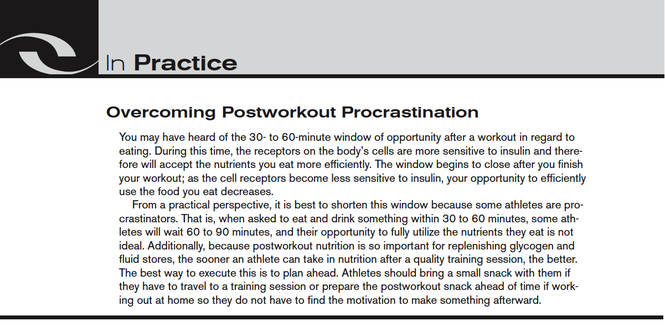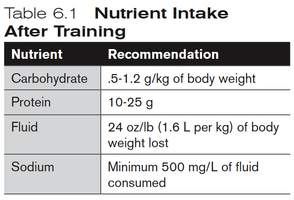Posttraining nutrient strategies
This is an excerpt from Performance Nutrition by Krista G Austin,Bob Seebohar.

Recovery is one of the most important factors in the process of adapting to training. The intake of fuel within 45 minutes of training can help optimize the recovery of energy stores, which is important for repairing muscle and maintaining a healthy immune system in athletes. In addition, consuming frequent small meals that contain the appropriate distribution of carbohydrate, protein, and fat also optimizes delivery of energy to the body throughout the remainder of the day to improve recovery and other factors such as body composition, which is critical for successful performance.
Carbohydrate Intake After Training and Competition
Carbohydrates are needed immediately after training or competition in order to begin the glycogen restoration process. Because glycogen stores are used during exercise, supplying the body with sources of carbohydrate is of utmost importance so the athlete can recover glycogen stores faster and be ready for the next session. This is even more important after a prolonged training session, especially if a second training bout is scheduled for the day.
After the initial postworkout consumption of a carbohydrate and protein snack, it is beneficial for athletes not seeking weight loss to eat another 1.0 to 1.2 grams of carbohydrate per kilogram of body weight 2 hours after the initial carbohydrate feeding and repeat throughout the next 6 to 8 hours in 2-hour increments. This strategy will refill glycogen stores the fastest, typically within 12 to 16 hours instead of 24 hours. Choosing any combination of carbohydrate during this time is beneficial as long as the foods are less processed and refined. Ideas include carbohydrate-rich snacks and meals balanced with lean protein such as a lean turkey sandwich with tomato, lettuce, cucumbers, pickles, and mustard; a nonfat milk-based fruit smoothie; a bowl of whole-grain cereal with berries and skim milk; or oatmeal made with skim milk and raisins. The goal is to maximize glycogen repletion, so eating smaller snacks or meals is preferred over larger ones that fill you up so much that you cannot eat again in another 2 hours.
Protein Intake After Training and Competition
Protein intake in the timeline immediately after training or competition can be used to repair muscle and restore muscle glycogen. Up to 20 grams of protein has been proven beneficial in facilitating carbohydrate uptake by the muscles, believed to result from protein's effect on the interaction of insulin with carbohydrate. An athlete's body size, training duration and intensity, and need to manage body weight will determine how much protein and carbohydrate is taken in. Athletes must learn to relate the size of a posttraining recovery snack to the intensity of the exercise bout. This is best exemplified by comparing a technique session to a high-intensity training session. After a technique session, a simple snack such as a yogurt that provides 6 to 8 grams of protein is sufficient, whereas a recovery shake containing 20 grams of protein would be appropriate after a high-intensity training session.
This rule can also be applied to athletes who are in a weight-loss phase. Regardless of training intensity, since energy intake must be reduced, the size of the postexercise snack must also be reduced. Thus, after a high-intensity session, 6 to 8 grams of protein would be sufficient, and the snack after a technique session could be completely eliminated. For athletes who must monitor body weight closely, a key component is minimizing food intake in the 2 hours after a resistance training session. This is the critical time period for increasing muscle synthesis. Although it would take multiple days and a significant increase in caloric intake to increase body mass, genetically some athletes are predisposed to building muscle mass rather easily. Thus, these athletes must do everything possible to keep this from happening, particularly in sports where a light body mass is required.
The second opportunity to take in protein is a meal within 2 hours after training. Protein at this point can be used to facilitate weight control or minimize the glycemic response of a meal, or it can serve a more minimal role in making a meal palatable. For athletes seeking to control body weight, protein can be increased in a meal to provide satiety and slow the rate at which glucose enters the blood. This will help optimize body composition, create satiety, and send the appropriate signals to the brain that indicate blood glucose is stable, and thus signals for hunger are not initiated. When weight loss is desired, the combination of protein, fiber, and water can create a sensation of fullness for a prolonged period of time. Protein has also been shown to help sustain lean body mass and cause a greater amount of fat loss. This is thought to be a result of its inefficient breakdown process, and thus very little usable energy is consumed, which helps further create a caloric deficit.
Athletes who need to keep body weight up or significantly replenish carbohydrate stores should minimize the amount of protein consumed in the recovery meal. Although protein can be used to make a meal palatable, these athletes need to minimize the satiety component. For athletes needing to gain weight, they must continue eating to create a positive energy balance. Athletes who deplete carbohydrate stores must consume enough food to fully restore muscle glycogen. Athletes competing in tournaments with bouts of high-intensity exercise for several hours daily need to pay particular attention to glycogen replenishment. This is most frequently seen in team sports and strength and power-type technical sports such as tennis and badminton.
The other role of protein is to minimize the glycemic response of snacks taken in between meals. This is important when trying to optimize body composition. Protein should be included in any snack eaten more than an hour before training, and it should make up at least 25 percent of the caloric value of the snack. This not only helps minimize an overconsumption of carbohydrate and increased snacking but also aids in satiety and slows the rate at which food empties from the stomach, thus controlling the glycemic response.
Fat Intake After Training and Competition
It has been theorized that intramuscular triglycerides (IMTGs) provide an energy source during exercise. These fats, stored inside the muscle, can decrease during exercise; thus, some researchers have studied the replenishment of IMTGs in the posttraining period. Although it has been shown that a high-carbohydrate and low-fat diet in the posttraining period may not fully replenish IMTGs, and moderate carbohydrate increases the stores more effectively, it is still unknown how important replenishing IMTG stores really is in terms of affecting performance.
Minimizing the amount of fat consumed in the first hour after a training session is recommended; the focus should be on ingesting carbohydrate, protein, fluid, and sodium. Fat—particularly omega-3 and monounsaturated—should be consumed at regular meals and snacks to provide a balanced macro-nutrient profile thereafter. Table 6.1 summarizes the nutrients that should be consumed in the period after training.

Learn more about Performance Nutrition.
More Excerpts From Performance NutritionSHOP

Get the latest insights with regular newsletters, plus periodic product information and special insider offers.
JOIN NOW


